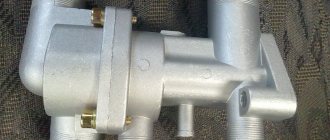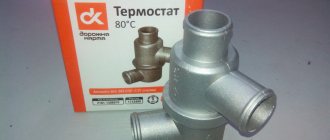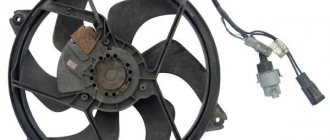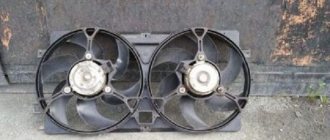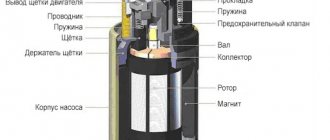Purpose
It is needed to control the temperature of the coolant circulating through it. How he does it? – It opens, releasing antifreeze through a large circuit of the cooling system and, when the temperature drops to a certain value, it closes.
In the closed position, the coolant moves in a small circle, bypassing the radiator. So it starts to heat up. Having reached a value, for example, VAZ 2101, the opening temperature of the thermostat is 80 degrees - it opens. In this case, the liquid flows through the main radiator and is cooled. Then it closes. This process occurs repeatedly throughout the engine's operation. This maintains the optimal temperature regime of the vehicle’s internal combustion engine.
Replacing the thermostat on a VAZ 2107
The operation of the thermostat is based on switching the circulation modes of the vehicle's coolant in a large or small circle. Distillation in a small circle warms up the engine soon after it starts, and when the antifreeze reaches the extreme temperature mark (85-90 degrees), a special valve opens, directing the liquid into a large circle and allowing it to cool. Replacing the VAZ 2107 thermostat may be necessary in case of interruptions during operation, leading to prolonged warm-up of the engine or its accelerated boiling.
Thermostat Specifications
The cylindrical thermostat is equipped with three outlets for pipes - from the engine, from the radiator and to the circulation pump. You can get acquainted with the design in more detail by looking at the cross-section of the thermostat:
Thermostat VAZ 2107 cross-section
When the engine starts, coolant flows through the cylinder block and pump, once above 80 degrees is reached, the main valve shutter begins to allow antifreeze through the radiator. As the liquid temperature rises, the throughput of the valve increases, while at the same time the bypass valve closes the flow of antifreeze from the engine. The mark of 94 degrees is considered the maximum at which the liquid moves exclusively in a large circle (the main valve is open, the bypass valve is pressed tightly).
Features of checking the thermostat
Testing the thermostat can be done without special equipment. To determine the quality of the thermostat, you need to open the hood of the car and start the engine in a cool state. Within a few minutes, the radiator pipe should maintain its initial temperature; it can be determined tactilely by placing your hand on the hose. When the operating range of 80-90 C is reached, part of the device and the nozzle area will quickly heat up. It is this sequence that characterizes the proper operation of the thermostat. The operating temperature of the VAZ 2107 injection engine can reach 95 degrees in summer weather.
The main malfunctions of the thermostat leading to the need for thermostat replacement:
- the engine is “boiling”, the valve is stuck closed;
- the engine takes a long time to warm up, the valve is stuck open. In winter, this leads to weak heating and poor heating of the interior;
- The valve does not close or open completely. In the summer it will boil, and in the winter it will be difficult to warm up.
Before replacing, you can check the thermostat in one more way. In this case, take a pan, add water and bring to a boil. In a cold state, the thermostat bypasses through holes 1 and 3; if it is heated in boiling water, it will bypass through 3 and 6.
If there is a need to replace a part, then which thermostat is better for the VAZ 2107 , of course, everyone chooses from their own experience, but we can recommend some manufacturers. The preference of the majority is given to PRAMO - a Russian development with a Polish thermoelement due to accelerated heating and long service life. Also worthy of attention are the Chinese BAUTLER and the Polish WEEN, a good option from.
You can consult with car service workers who are familiar with the quality of their work. From practice, perhaps the worst is the Chelyabinsk one from.
How to change a thermostat
Before replacing the thermostat, check the rigidity of the pipes. The fact is that if these parts have been standing for a long time, they become rigid and crack at the most inopportune moment, so it is better to replace them in advance. To replace the thermostat on a VAZ 2107 you will need:
Thermostat VAZ 2107
The replacement process is not complicated and can be done independently. Dismantling is carried out both with the help of an inspection hole and without it. Depending on the type of engine, carburetor or injection, the necessary stages of work are selected. Installing the latter is somewhat more complicated and requires additional tools.
The coolant is drained from the engine, the latter must cool completely after previous operation. For convenient operation, remove the battery. The heater tap is opened and the radiator filler cap is removed. After preliminary installation of the container, the drain of the cylinder block and radiator opens. Next, you need to remove the old clamps and carefully release the thermostat from the pipes.
For reliability, lubricate the pipes with sealant. After stable fixation of the working part, it is securely secured with clamps, and the battery is also returned to its original place. If the pipes are unsuitable, they can also be replaced with new ones. Next, add antifreeze and test the thermostat using the above method or using a pyrometer.
What does it consist of
- Frame. It is made of stainless steel
- Main valve - circulates coolant through the radiator
- Small circuit valve - its name speaks for itself
- Spring. Due to the elastic force, it returns the valves to their original position, closing them
- Cylinder with technical wax and rod. The rod pushes the valves, opening them
Cylinder with wax
It occupies an important place in the design. It contains wax, which expands when heated. There is a rubber coupling in the cylinder cavity, and the inner end of the rod is located inside. Its outer part is located outside the cylinder.
When wax is heated to a certain temperature, it expands. In domestic VAZ models it is 80 degrees. The coupling with the rod is squeezed out, resting against the body.
Springs
The design includes two springs. They help the valves “return” to their original position after the coolant has cooled, reliably isolating the two circulation circuits of the system from each other.
The thermostat itself is placed in a cylindrical housing with three pipes. Two are connected to different circulation circuits, the third to a water pump (pump).
Video showing how a thermostat works and is made:
Thermostat operating principle
It is the same for all models, both for the domestic automobile industry and foreign-made cars. The difference is in the opening temperature of the thermostat and design features. For example, there are electric ones, where the opening temperature is regulated by a special heating element. Now we will talk only about mechanical ones installed in most cars.
In the initial position, the valve of the large circle is closed, only the small one is open. Coolant flows from the cylinder block into the housing. Through an open valve, it circulates along a small circuit - from the cylinder block and engine head, passes through the thermostat, pump and returns back to the engine.
When the opening temperature reaches 80 degrees, the wax in the cylinder expands. Squeezes out the movable rod, which rests against the body. Further heating of the antifreeze leads to a greater output of the rod from the cylinder. Since it has already rested against the body, it has nowhere else to move out; it pushes the cylinder itself in the opposite direction.
Remember, there are two valves attached to the wax cylinder. They begin to move with him. At the same time, the valve of the large circle opens slightly, and the small one closes. Circulation begins through two cooling circuits.
With a further increase in temperature, the rod extends to its full length. Which leads to the complete closure of the small circle valve and the opening of the large one. In this case, all the liquid “flows” through the radiator and returns to the engine.
The liquid cools, the wax contracts, and the rod is partially immersed deep into the cylinder. Due to the return springs, the valves try to return to their original position.
Thermostat VAZ 2101
“Kopeykas,” like other representatives of classic VAZs, were equipped with domestically produced thermostats, produced under catalog number 2101–1306010. The same parts were installed on cars of the Niva family.
The thermostat is used to maintain optimal engine temperature
Why do you need a thermostat?
The thermostat is designed to maintain optimal engine thermal conditions. In essence, it is an automatic temperature regulator that allows you to quickly warm up a cold engine and cool it when it heats up to the limit value.
For the VAZ 2101 engine, the optimal temperature is considered to be in the range of 90–115 oC. Exceeding these values is fraught with overheating, which can cause the cylinder head gasket to burn out, followed by depressurization of the cooling system. Moreover, the engine may simply seize due to an increase in the size of the pistons caused by high temperatures.
If the cylinder head gasket is damaged, the cooling system depressurizes.
This, of course, will not happen with a cold engine, but it will not be able to operate stably until it warms up to the optimal temperature. All calculated characteristics of the power unit regarding power, compression ratio and torque directly depend on the thermal conditions. In other words, a cold engine is not able to produce the performance declared by the manufacturer.
Design
Structurally, the VAZ 2101 thermostat consists of three blocks:
- non-separable body with three pipes. It is made of metal that has good chemical resistance. It can be copper, brass or aluminum;
- thermocouple This is the main part of the device, which is located in the central part of the thermostat. The thermoelement consists of a metal body, made in the shape of a cylinder, and a piston. The internal space of the part is filled with special technical wax, which has the property of actively expanding when heated. Increasing in volume, this wax pushes a spring-loaded piston, which, in turn, actuates the valve mechanism;
- valve mechanism. It includes two valves: bypass and main. The first serves to ensure that the coolant has the opportunity to circulate through the thermostat when the engine is cold, bypassing the radiator, and the second opens the way for it to get there when heated to a certain temperature.
The bypass valve opens at low temperatures and allows coolant to pass directly into the engine, and the main valve opens when heated to a certain temperature, directing the liquid through a large circuit to the radiator
The internal structure of each unit is of only theoretical interest, because the thermostat is a non-separable part that can be changed entirely.
The thermostat consists of the following elements: 1 - inlet pipe (from the engine), 2 - bypass valve, 3 - bypass valve spring, 4 - glass, 5 - rubber insert, 6 - outlet pipe, 7 - main valve spring, 8 - main valve seat valve, 9 - main valve, 10 - holder, 11 - adjusting nut, 12 - piston, 13 - inlet pipe from the radiator, 14 - filler, 15 - holder, D - fluid inlet from the engine, R - fluid inlet from the radiator, N - liquid outlet to the pump
Operating principle
The VAZ 2101 engine cooling system is divided into two circles through which coolant can circulate: small and large. When starting a cold engine, liquid from the cooling jacket enters the thermostat, the main valve of which is closed. Passing through the bypass valve, it goes directly to the water pump (pump), and from it back to the engine. Circulating in a small circle, the liquid does not have time to cool, but only heats up. When it reaches a temperature of 80–85 oC, the wax inside the thermoelement begins to melt, increasing in volume and pushing the piston. At the first stage, the piston only slightly opens the main valve and part of the coolant enters the large circle. Through it, it moves to the radiator, where it cools down, passing through the heat exchanger tubes, and, already cooled, is sent back to the engine cooling jacket.
The degree of opening of the main valve depends on the coolant temperature
The main part of the liquid continues to circulate in a small circle, but when its temperature reaches 93–95 oC, the thermoelement piston leaves the housing as much as possible, completely opening the main valve. In this position, all the coolant moves in a large circle through the cooling radiator.
Video: how the thermostat works
Which thermostat is better
There are only two parameters by which a car thermostat is usually selected: the temperature at which the main valve begins to open and the quality of the part itself. Car owners have different opinions regarding temperature. Some want it to be higher, i.e. the engine takes less time to warm up, others, on the contrary, prefer to warm up the engine longer. The climatic factor must be taken into account here. When operating a car in normal temperature conditions, a standard thermostat that opens at 80 oC is suitable. If we are talking about cold regions, then it is better to choose a model with a higher opening temperature.
As for the manufacturers and quality of thermostats, according to reviews from owners of “kopecks” and other classic VAZs, the most popular are parts made in Poland (KRONER, WEEN, METAL-INKA), as well as in Russia with Polish thermoelements (“Pramo”). Temperature controllers made in China should not be considered as a cheap alternative.
Polish-made WEEN thermostats have proven themselves to be excellent among VAZ 2101 owners
Where is the thermostat located
In the VAZ 2101, the thermostat is located in the front part of the engine compartment on the right side. You can easily find it by the thick cooling system hoses that go to it.
In a VAZ 2101 car, the thermostat is located in the engine compartment on the right
Malfunctions and how they manifest themselves
There are three types of breakdowns:
- The small circle valve is constantly open, regardless of the coolant temperature. This happens when it becomes jammed or a foreign object gets into it: scale, dirt, etc. In this position, the engine will always overheat, its temperature will rise until the antifreeze in the system boils. Because it does not circulate in a large circle, does not pass through honeycomb radiators, and is not cooled.
How does this manifest itself? In motion, air passing through the radiator cools its cells, through which the liquid passes, it gives off heat. She's cooling down. If the thermostat is stuck in the closed position, then there will be no circulation in a large circle, the radiator will not participate in the engine cooling system, which means the temperature will constantly rise. This is indicated by the engine temperature indicator. If nothing is done, the liquid will boil in the system and you may end up with expensive engine repairs.
- The large circuit valve is always open. This is the opposite situation. The fluid will constantly circulate through the radiator. The engine will not be able to warm up to the required temperatures. This will lead to increased wear of its parts and excessive fuel consumption.
How does it manifest? The engine idles, but its temperature does not rise. It will fall as it moves. This is especially noticeable in the cold season.
- Valves are stuck in the middle position. The liquid circulates through two circuits. If the car is stationary and the engine is idling, then such a malfunction will be difficult to notice. The engine warms up, but not at the same speed as usual. As the vehicle moves, the coolant temperature will drop quickly.
Which thermostats to choose for VAZ (Lada) 2101/2103/2106?
Last month, PartReview users preferred LUZAR. 60% of positive votes belong to this manufacturer.
Gates thermostats took second place – 20%.
Vernet closes the top three with 20% of the votes.
In the general rating of thermostats, which takes into account the opinions of owners of different brands and models of cars, these brands occupy the following positions:
- LUZAR received 7th place, PR score - 65. Data from 69 reviews and 220 votes are taken into account.
- Gates was ranked 10th with a PR score of 56 based on 69 reviews and 85 votes.
- Vernet - 6th place, and the PR score was 70. Data from 59 reviews and 181 votes are taken into account.
How to check the thermostat of a VAZ 2106 without removing it from the car
We start the engine. After a few minutes, we feel with our hand the hose that goes from the cylinder block to the upper part of the thermostat housing. If it is cold and the lower radiator hose is warm, it means that the valve of the large circle is stuck in the open position and the small one is closed.
The opposite situation. The engine has warmed up to operating temperature. We try to touch the upper and lower radiator hoses. If they and the radiator cells are cold, then the valve of the large circle is closed, and the small circle is open and jammed. A secondary sign of a malfunction in such a situation is that the radiator forced cooling fan does not turn on, if one is installed.
And the last option is to determine if the thermostat is malfunctioning - the engine has been running for several minutes, according to the sensor, its temperature has begun to rise, but has not yet reached the green zone. We put our hand on the radiator hoses and at the outlet of the cylinder block. If their temperature is the same, then the valves are in the middle position and antifreeze “flows” through both cooling circuits.
Having decided on possible breakdowns, you need to change the thermostat; we’ll talk about how to do this in the following articles. Good luck to everyone on the roads!
Video on the topic:
A visual demonstration of the operating principle of the thermostat:
Checking the thermostat on VAZ 2105, 2107, 2108, 2109, 21099 cars
Let's check the functionality of the thermostat of the carburetor engine cooling system of VAZ 2105, 2107, 2108, 2109, 21099 cars.
To check the thermostat, assess the correctness of its operation (whether the valve is jammed or not), you need to know its role in the car's cooling system and the principle of operation. The thermostat separates two circles of the cooling system (small and large) and has two valves: bypass and main. While the engine is warming up, coolant circulates through the small circle and the open thermostat bypass valve. The thermostat prevents it from mixing with the liquid from the large circle and thereby helps the engine warm up quickly.
More details about the operation of the thermostat on the page: “Thermostat operation diagram”
As it warms up (coolant temperature is about 87º - 2108, 2109 and 80-85º - 2105, 2107), the bypass valve closes, and the main one opens, and the liquid flows into a large circle. At a temperature of 102º (94º for VAZ 2105, 2107), the main thermostat valve is fully open, and the additional one is closed. Circulation occurs through a large circle, providing the required temperature conditions for normal engine operation.
Therefore, the simplest way to check the functionality of the thermostat is by touch, directly on the car. When operating correctly, its upper part warms up first, and then the lower part.
The procedure for checking the thermostat on VAZ 2108, 2109, 21099 cars without removing it from the engine
When the engine warms up, circulation occurs in a small circle. Warms up: cylinder block, cylinder head, carburetor heating block, stove, upper part of the thermostat. We check the heating of the thermostat with our hands: its upper part should be warm, and after a few minutes it becomes hot. The bottom of the thermostat remains cold. In addition, the lower hose to the radiator will also be cold, and the upper one will be slightly heated.
After some time, the lower part of the thermostat and the lower radiator hose suddenly become hot - this opens the main thermostat valve. Circulation went through the radiator (large circle).
Lower and upper parts of the thermostat for the VAZ 2108, 2109, 21099 engine cooling system
The procedure for checking the thermostat on VAZ 2105, 2107 cars without removing it from the engine
The check is similar to the check on VAZ 2108, 2109, 21099, only when circulating in a small circle, the following elements of the cooling system warm up: the cylinder head tee, the upper hose to the radiator, the upper radiator tank, the heater. The lower part of the radiator and its lower hose remain cold. After the thermostat operates at a temperature of 80-85º (the coolant temperature gauge needle is 3-4 mm from the red zone), the lower part of the thermostat and the lower radiator tank warm up.
Lower and upper parts of the thermostat for the VAZ 2104, 2105, 2107 engine cooling system
Checking the removed thermostat
You can check the removed thermostat of VAZ 2105, 2107, 2108, 2109, 21099 cars. To do this, immerse it in a container with hot water (preheating temperature 73-75º). We heat the water further, stirring it, and observe the movement of the main thermostat valve. When the valve begins to open (approximately 1 mm), the temperature of the liquid should be measured. If the thermostat is working, it will be 81±5º for VAZ 2105, 2107 and 87±2º for VAZ 2108, 2109, 21099. A faulty thermostat should be replaced.
Notes and additions
— The stroke of the main thermostat valve at 102º for VAZ 2108, 2109, 21099 is about 8 mm. For VAZ 2105, 2107 at 94º from 6 to 8 mm.
